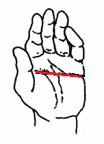A chromosomal abnormality characterized in most cases by the presence of extra genes associated with the 21st chromosome, which in its normal state contains just 30 or so genes. Being the most common congenital disorder in humans, its estimated incidence ranges from about one per 700 to one per 1000 live births. The risk of bearing a fetus with Down’s syndrome increases with maternal age such that it is more than 1 in 50 after 35 years of age, with 60 to 70% of all Down’s syndrome being born to mothers older than this age. The signs, or ‘stigmata’ associated with the syndrome included small, anteroposteriorly flattened skull, short, flat-bridge nose, epicentral folds, short phalanges, widened spaces between the first and second digits of the hands and feet (Goldstein’s sign), short little fingers curved inward (Siegert’s sign), the palmar crease of head line is very long (Sydney line), and a simian palmar crease or line (see figure below). There is a decline in immune function, with an early onset of Alzheimer’s disease occurring in the fourth or fifth decade. Moreover, children and adolescents with Down’s syndrome have a 15- to 20-fold greater of leukaemia compared to so-called normosomic individuals (and which is associated with the presence of a Sydney line).
